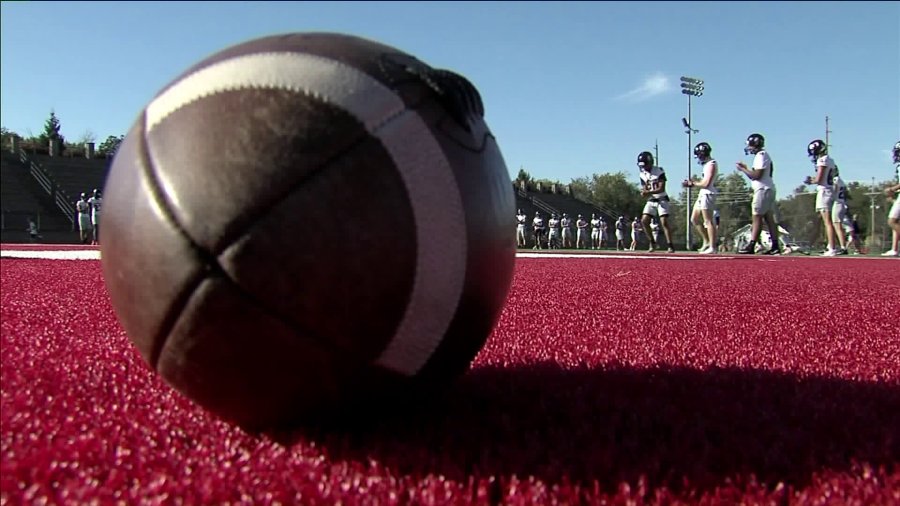Storm Reports: Severe weather causes delays to Kansas HS football. The recent storms that swept through Kansas brought more than just rain and wind. They also brought a wave of disruption to high school football games, forcing postponements, cancellations, and even venue changes.
The impact was felt by players, coaches, and spectators alike, highlighting the importance of weather preparedness in sports.
The storm brought strong winds, heavy rainfall, and even potential tornadoes, forcing school officials and athletic organizations to implement safety protocols. The weather impacted the game schedule, leading to postponements, cancellations, and even changes in venue. The safety of players, coaches, and spectators was paramount, and everyone involved had to adapt to the unpredictable conditions.
Impact of Severe Weather on Kansas High School Football
Severe weather, including heavy rain, strong winds, and even potential tornadoes, has disrupted high school football games across Kansas. These weather events have led to game delays, postponements, and even cancellations, impacting the schedules and outcomes of many teams.
Game Delays and Postponements
The severity of the storms has forced many games to be delayed or postponed. The heavy rain and strong winds have made playing conditions unsafe, while the threat of tornadoes has added an extra layer of concern. For example, the game between the Topeka High Trojans and the Washburn Rural Vikings was delayed for over an hour due to heavy rain and strong winds.
The game was eventually postponed to the following week.
Impact on Game Schedules
The weather disruptions have had a significant impact on the game schedules. Games have been postponed, canceled, and even moved to different venues. For example, the game between the Wichita East Aces and the Wichita North Grizzlies was canceled due to the threat of tornadoes.
The game was later rescheduled to the following week. In some cases, games have been moved to indoor facilities to avoid the harsh weather conditions.
Safety Concerns and Protocols
The safety of players, coaches, and spectators is paramount during severe weather events. School officials and athletic organizations in Kansas implemented comprehensive safety protocols to ensure everyone’s well-being during the storms.These protocols involved various measures to communicate weather warnings and alerts effectively, establish evacuation procedures, and provide safe havens during the storm.
Communication of Weather Warnings and Alerts, Storm Reports: Severe weather causes delays to Kansas HS football
Effective communication is crucial in disseminating weather warnings and alerts to all stakeholders. School officials and athletic organizations utilized multiple channels to ensure timely and accurate information reached players, coaches, and spectators.
- School and Athletic Organization Websites and Social Media Platforms:Websites and social media platforms served as primary channels for sharing weather updates, alerts, and any changes to game schedules or cancellations.
- Email and Text Message Notifications:Schools and athletic organizations sent email and text messages to players, coaches, parents, and spectators, providing real-time updates on weather conditions and safety instructions.
- Public Address Systems at Venues:Stadium and field public address systems were used to broadcast weather warnings and alerts, instructing attendees on appropriate safety measures.
- Local Media Outlets:Collaboration with local news stations and radio broadcasts ensured wider dissemination of weather information and emergency updates.
Evacuation Procedures
In the event of severe weather, schools and athletic organizations established clear and concise evacuation procedures to ensure the safe movement of players, coaches, and spectators to designated shelters.
- Designated Safe Locations:Schools and athletic organizations identified designated safe locations, such as school buildings, gymnasiums, or nearby community centers, where players, coaches, and spectators could seek shelter during the storm.
- Evacuation Routes and Procedures:Clear evacuation routes were established, with designated personnel guiding players, coaches, and spectators to safe locations. Evacuation procedures included designated assembly points and specific instructions for orderly movement.
- Emergency Personnel on Site:First aid personnel, athletic trainers, and school officials were on hand to assist with evacuation and provide medical attention if needed.
The Impact on Players, Coaches, and Spectators
The severe weather that swept through Kansas not only disrupted high school football games but also significantly impacted the players, coaches, and spectators involved. The experience left a lasting impression on everyone present, from the adrenaline rush of the storm’s arrival to the frustration of delays and cancellations.
Impact on Players and Coaches
The sudden change in weather conditions brought a unique set of challenges for players and coaches. Players had to adapt to the shifting weather patterns, while coaches had to make critical decisions about player safety and game strategy.
- Many players described the experience as both exhilarating and unsettling. The storm’s intensity added an element of unpredictability to the game, forcing them to react quickly and stay focused amidst the chaos.
- Coaches faced the difficult task of balancing the competitive spirit of the game with the need to prioritize player safety. They had to make tough calls about whether to continue playing, knowing that a sudden downpour could turn the field into a slippery hazard.
Impact on Spectators
Spectators, too, were affected by the weather disruptions. The delays and cancellations caused inconvenience and frustration, disrupting their plans and leaving them unsure about the fate of the game.
- Many spectators had traveled long distances to support their teams, only to find their plans thrown into disarray by the unexpected weather. The uncertainty of the situation created anxiety and disappointment, as they wondered whether the game would resume or be canceled altogether.
- The delays also presented logistical challenges for spectators. Some had to find shelter from the storm, while others faced long waits in the stadium, hoping for updates on the game’s status.
The Future of High School Football in Kansas
The recent severe weather events that have disrupted high school football games in Kansas raise important questions about the future of the sport in the state. The safety of players, coaches, and spectators must be paramount, and climate change is likely to exacerbate these challenges.
Safety Protocols and Game Scheduling
The recent severe weather events highlight the need for improved safety protocols and game scheduling.
- Enhanced Weather Monitoring Systems:Schools should invest in more sophisticated weather monitoring systems that provide real-time updates on severe weather threats. This includes utilizing Doppler radar, lightning detection systems, and weather apps that provide alerts for tornadoes, heavy rain, and high winds.
- Clearer Emergency Response Plans:Schools should develop comprehensive emergency response plans for severe weather events. These plans should include designated evacuation routes, designated safe zones, and procedures for communicating with players, coaches, and spectators.
- Flexible Game Scheduling:Schools should consider implementing more flexible game scheduling options, such as postponing games due to severe weather threats or playing games on different days of the week. This could help reduce the risk of games being interrupted or canceled due to weather.
Obtain recommendations related to Simone Biles’ Tour Costume Detail Shows She’s the Boss as Well as the GOAT that can assist you today.
The Impact of Climate Change
Climate change is expected to increase the frequency and intensity of severe weather events in Kansas.
- Heat Waves:Extreme heat can pose serious health risks to players, particularly during practices and games. Schools should consider implementing heat acclimatization protocols, providing access to shade and hydration, and adjusting practice schedules to avoid the hottest parts of the day.
- Drought:Droughts can lead to dry and brittle fields, increasing the risk of injuries. Schools may need to invest in irrigation systems or consider playing games on artificial turf to mitigate this risk.
- Increased Storm Activity:Climate change is likely to increase the frequency and intensity of thunderstorms, tornadoes, and other severe weather events. This will require schools to be even more vigilant in monitoring weather conditions and implementing safety protocols.
Weather Factors to Consider
| Weather Factor | Impact on Game | Safety Considerations |
|---|---|---|
| Temperature | High temperatures can lead to heat exhaustion and dehydration in players. | Implement heat acclimatization protocols, provide access to shade and hydration, and adjust practice schedules. |
| Humidity | High humidity can make it difficult for players to cool down, increasing the risk of heat-related illnesses. | Provide access to shade and hydration, and consider shortening practice sessions or games. |
| Wind | Strong winds can make it difficult to pass and kick the ball, and can also create dangerous conditions for players and spectators. | Consider postponing games or adjusting game times to avoid high winds. |
| Precipitation | Heavy rain or snow can make the field slippery and dangerous, and can also make it difficult for players to see the ball. | Consider postponing games or using a covered stadium. |
| Lightning | Lightning is a serious safety hazard, and can strike even when the sky is clear. | Implement a lightning detection system and evacuate players, coaches, and spectators to a safe location when lightning is detected. |
Final Summary

This event served as a stark reminder of the unpredictable nature of weather and its potential to disrupt even the most well-planned sporting events. It also underscores the importance of weather forecasting and preparedness in sports, particularly for outdoor events like high school football.
As we move forward, it’s essential for school officials, athletic organizations, and emergency responders to continue working together to ensure the safety of everyone involved in high school sports.
Questions Often Asked: Storm Reports: Severe Weather Causes Delays To Kansas HS Football
What were the specific weather conditions that caused the delays?
The storm brought strong winds, heavy rainfall, and even potential tornadoes, leading to safety concerns and disruption to the games.
How did the storm impact the game schedule?
The weather caused postponements, cancellations, and changes in venue for high school football games in Kansas.
What safety protocols were implemented?
School officials and athletic organizations implemented safety protocols, including weather warnings, evacuation procedures, and communication plans.
What are the future implications for high school football in Kansas?
The recent severe weather events have prompted discussions about potential changes to safety protocols and game scheduling, as well as the potential impact of climate change on high school sports in Kansas.
 CentralPoint Latest News
CentralPoint Latest News




